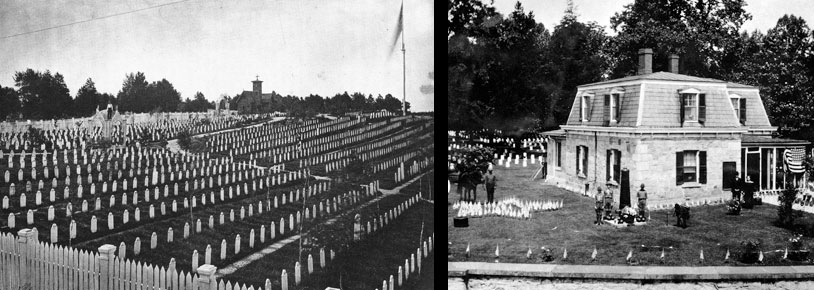

Civil War Era National Cemeteries: Honoring Those Who Served
Crown Hill National Cemetery
Indianapolis, Indiana
 |
Crown Hill National Cemetery Courtesy of the Department of Veterans Affairs, National Cemetery Administration, History Program |
The first burials in Crown Hill Cemetery occurred in 1864, and the site quickly became the foremost cemetery in Indianapolis. The cemetery has a Victorian landscape design featuring curving walkways, Romantic landscaping, and retention of the natural topography. The cemetery is the final resting place for many prominent Hoosiers, including President Benjamin Harrison, poet James Whitcomb Riley, and notorious gangster John Dillinger. Today, Crown Hill Cemetery covers more than 550 acres, making it one of the largest private cemeteries in the country.
In 1866, the Federal Government purchased 1.4 acres of land within Crown Hill Cemetery to establish Crown Hill National Cemetery. Union soldiers who died in local hospitals, or who were stationed in area posts, were first buried in the city’s Green Lawn Cemetery. With the opening of Crown Hill National Cemetery, the soldiers’ remains were reinterred in one central location. Burials continued until 1969 when the national cemetery closed to new interments.
The national cemetery is approximately 2,000 feet west of the main entrance to Crown Hill Cemetery, adjacent to the imposing Gothic Chapel, built in 1875. All of the graves in the national cemetery lay in orderly rows, running from the southwest to the northeast. A flagpole is located at the center of the national cemetery in a circular plot between the two sections of graves. No fences, walls, or gates separate the national cemetery from the surrounding private cemetery, though a paved walkway circles the national cemetery. Several seacoast artillery cannons are located near the flagpole and throughout the national cemetery, each planted upright in a concrete base. The national cemetery also features the Women’s Relief Corps/Grand Army of the Republic Monument, a square stone column topped with an eagle that was erected in 1869.
| Plan your visit |
Crown Hill National Cemetery is located within the confines of Crown Hill Cemetery, at 700 West 38th St., in Indianapolis, IN. The cemetery is open for visitation daily from dawn to dusk. No cemetery staff is present onsite. The administrative office is located at Marion National Cemetery, and is open Monday-Friday from 8:00am to 4:30pm; it is closed Federal holidays except Memorial Day. For more information, please contact the cemetery office at 765-674-0284, or see the Department of Veterans Affairs website. While visiting, please be mindful that our national cemeteries are hallowed ground. Be respectful to all of our nation’s fallen soldiers and their families. Additional cemetery policies may be posted on site. The surrounding Crown Hill Cemetery is a featured stop of the National Park Service Indianapolis Discover Our Shared Heritage Travel Itinerary. The gateway, office building, and chapel and vault of Crown Hill Cemetery were photographed to the standards established by the National Park Service’s Historic American Buildings Survey. For more information on Crown Hill Cemetery and its history, please call 317-925-3800 or see their cemetery website. Crown Hill Confederate Plot is also located within Crown Hill Cemetery. Crown Hill National Cemetery was photographed to the standards established by the National Park Service’s Historic American Landscapes Survey. |